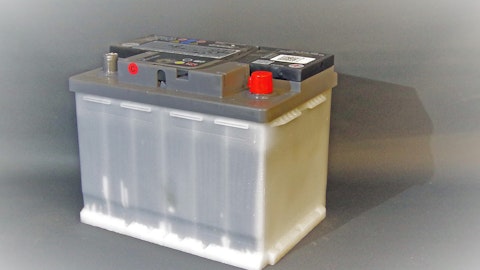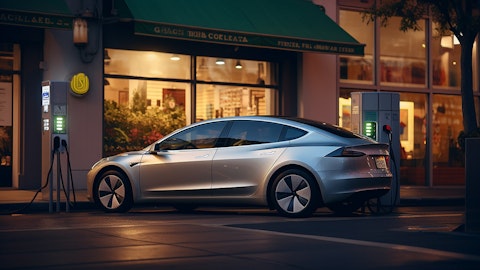Jeffrey Cote: Yeah. I’d be glad to. In 2024, we are being much more conscious to follow IHS forecast, right. In the past, we have done adjustments based upon our weighted impact in the business and so forth in terms of where we have content on various platforms and different OEMs. We believe it’s better for us to focus on the IHS forecast, and then share with you how we believe that is going to impact our company growth in the automotive business. So, we’re following IHS forecast right now. The latest forecast from IHS for the full year is down and call it 50 basis points. We believe that our auto market, based upon launches, that we have engaged with customers to understand what is going to happen this year in terms of their product launches and some of those were carryover from 2023 that were delayed into 2024.
We feel good about where that automotive business is. We’re giving you a view into the full year, but we’re guiding specifically to the first quarter. So, we would call the automotive market up a couple 100 basis points — our business, up a couple 100 basis points in a market that’s down, call it 1%. In the HVOR market, we believe that the third parties are forecasting somewhere around 4% down. As I’d mentioned in my prepared comments, that’s a result of strength in China on-road truck, but weakness in North America and Europe on-road also in construction. So, that would be the market expectation that we have baked into our view for the heavy vehicle market. And then in industrial, the first half is going to be a little bit more tough sledding with some continued destocking, but we do expect that to recover, to get back to single-digit growth for the full year, but the first half of the year will be down a little bit.
Aerospace, the shining star, really, in terms of market dynamics. We would continue to expect that market to be up high single digits in 2024.
Jacob Sayer: Thank you, Matt, for the question.
Operator: The next question comes from Christopher Glynn with Oppenheimer. Please go ahead.
Christopher Glynn: Yeah. Thanks, Brian. Welcome. Wanted to ask you a question about free cash flow. I know you’re kind of new to the role here, but conversion missed and was light in the year after a soft 2022. And then your 2024 guidance at 65% to 70% compares to, I think, 75% to 80% long-term outlook. So, curious what your thoughts are on where the gates are and ability to lean working capital flows and maybe some of the operating disciplines that should drive better free cash flow conversion?
Brian Roberts: Yeah, no, great question. I mean, as we’ve looked at the last couple of years to try to account for timing, you’re right. We’ve been basically kind of converting half or slightly over half of our adjusted net income into free cash flow. I can sum it up in one word. It’s inventory, right? And ultimately, that’s the main — big piece of it for us and a lot of focus. Obviously, over the last couple of years, there was a different prioritization where we needed to make sure the supply chain had enough redundancy in it or enough quantity in it, if you will, to be able to make sure we could meet customers demands. That was really important to the company. Now, in a more normalized environment, we’re working hard to start taking down those inventory balances.
That said, it’s going to take a little bit of time, and that’s why we’ve talked about higher cost of inventory that will impact adjusted operating margins in the first half of the year as well as we just work through kind of that overall normalization. Certainly receivable management, company does a good job there, but we can do better. And one of the reasons for, as we look at the end of this year, end of 2023 and beginning of 2024, you’ll look at the balance sheet and note we really — we didn’t try to manage payables, right? So we let that kind of naturally flow as it should, which is why we got the result for 2023 and where we think we get the improvement for 2024. And then to your point, on the longer term, again, I’ll come back to inventory.
I mean, that’s going to be a key piece for us.
Jacob Sayer: Thank you, Chris, for the question.
Operator: The next question comes from Samik Chatterjee with J.P. Morgan. Please go ahead.
Samik Chatterjee: Hi. Thanks for taking my question. Jeff, I guess I had one for you. It’s bit more on the strategic front. I mean, I think out of today’s earnings report, one of the investor sentiments that I think we’ll hear is that the strategy that you’ve laid out in terms of the transformation that continues to be sort of fluid and sort of change over time, not in relation to electrification, but the adjacencies of it, including sort of, you did an Investor Day in September and now you’re sort of restructuring INSIGHTS and some of those sort of adjacencies continue to sort of be fluid. Any sort of thoughts around when we can sort of more get to a more stable state in terms of strategy in relation to sort of tracking execution relative to it? Because I think the bigger challenge here seems to be in terms of just the macro developments that are happening. But you’re changing your strategy in response to that as well.
Jeffrey Cote: Yeah. It’s a great question, and we talked a little bit about this at Investor Day, about the fact that several years ago when I took over in March of 2020, we realized there was going to be significant amounts of change in the end markets that we serve. And I’ve been known to say there’s going to be more change in the next 10 years than there has been in the last 50. And I think we all agree with that. That resulted, that in us needing to really look at what those changes were going to be and where we needed to invest to make sure that we stayed highly relevant in the end markets that we serve. And what we had identified early on was three areas around autonomy, around INSIGHTS or IoT connectivity, if you will, and electrification.





